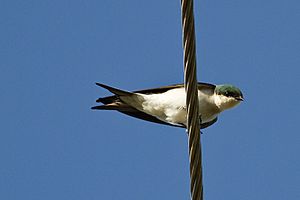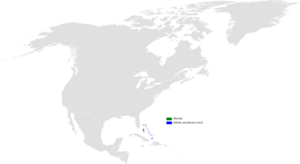Bahama swallow facts for kids
Quick facts for kids Bahama swallow |
|
|---|---|
 |
|
| Conservation status | |
| Scientific classification | |
| Genus: |
Tachycineta
|
| Species: |
cyaneoviridis
|
 |
|
| Synonyms | |
|
|
The Bahama swallow (Tachycineta cyaneoviridis) is a beautiful bird that lives only in The Bahamas. It's a type of swallow, and sadly, it's an endangered species. This means there aren't many left in the world.
What They Look Like
These swallows are very pretty! They have a shiny green head and back. Their upper wings are blue, and their tail and wingtips are black. Their belly and chin are white.
Where Bahama Swallows Live
Bahama swallows only make their nests and raise their young in special forests called pineyards. These forests are found on four islands in the northern Bahamas: Andros, Grand Bahama, Abaco, and New Providence. The number of swallows nesting on New Providence has dropped a lot. They might not even nest there anymore.
During the winter, Bahama swallows fly to the eastern Bahamas and the Turks and Caicos Islands. Sometimes, during their travels, a few might be seen in south Florida, the Florida Keys, Cuba, or even South America.
These birds mostly live in the Bahamian pineyards. However, they can sometimes get used to living near cities. Even though they don't nest in marshlands or open fields, they need these places to find food. Like all swallows, they catch and eat flying insects.
How They Raise Their Young
Bahama swallows build their nests inside old holes made by West Indian woodpeckers. These holes are usually found in Caribbean pine trees. They use pine needles, small twigs from Casuarina trees (which are not native to the Bahamas), and grass to build their nests. They then line the nests with soft feathers from other birds.
Female Bahama swallows usually lay three eggs. The eggs hatch after about 15 days. The young birds stay in the nest for around 22 days before they are ready to fly.
See also
 In Spanish: Golondrina de las Bahamas para niños
In Spanish: Golondrina de las Bahamas para niños


